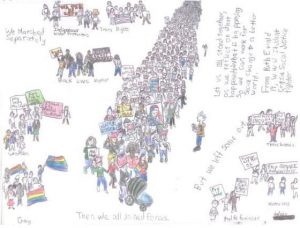Across the world, there are Hollywood movies and McDonalds. These are part of what could be described as part of global culture(Eitzen). The spread of how to make art and what art should depict is also part of our global culture and ideas of what art should be in many ways follows that of other globalized cultural phenomenon, but it has some differences.
Art has always been a global phenomenon, so when examining art in the context of globalization the question is not how did art get to be everywhere, but rather how has globalization influenced and changed production of art.
I’ve selected some examples that demonstrate the some of the effects of globalization on art, specifically African art. As globalization happens ideas spread and so do ideas about how to make art. As Jayna Clemens puts it “Colonization had a major impact on Africa’s culture and history, including contemporary African art.” (Clemens 2). Colonization will unevenly (from colonizer to colonized) spread ideas about culture where ever it is located. Western seems to spread everywhere else.
For example, look at the work of Chéri Samba. It almost looks like it could be painted in Europe by a European, what shows the viewer that it is not European is his works distinctly depict Africa as a content and African people. His work is created in a post-colonial Democratic Republic of Congo (Chéri), which means that it must be influenced by European art. According to Clemens: “During post-colonialism, conceptual art design began to make its way into contemporary African art”. It is evident that in Samba’s work is contemporary in style and time. Samba is one example of an artist working in both a global art culture and a local art culture.
Even if it is Western culture that usually influences the world, there are examples of the non-Western world influencing the West. Here is an example. These are examples of ornate coffins made by Kane Quaye. These coffins are used to burry people and are found in many Western museums. At the Magiciens de la Terre show, Westerners first saw the works of a few non-Western artists, including Quaye’s coffins and the viewers where impressed (Kerman). The Magiciens de la Terre show, was an example of the world sharing culture, even though the amount of sharing was minimal, instead of globalization just being an exporting of culture.
I think in a cultural exchange between a non-Western country and a Western country, I think the western country will demand “authenticity”, which the definition of which is set to a particular time and place, and not to do with what the non-Western culture actually creates. Cultures constantly change what is the kind of food, visual art, music etc. that a culture uses and enjoys constantly changes. Artist move, cultural and national identity change. In the case of black British artist Yinka Shonibare, he is expected to create “African looking” art. In response to this pressure he creates The Victorian Philanthropist’s Parlour (Kerman), here. This art work and person are examples of globalization’s power to spread ideas and people around the world. The fabric is Dutch wax print fabric, which originates from Indonesian fabric designs. This kind of fabric is popular in Africa (I don’t know which country or region Dutch wax print is popular in). The figures are of black British footballers. (Kerman). The elements that went into this art are from the Netherlands, Indonesia, and Britain via Nigeria and generally the African continent.
The previous examples show that globalization is a two-way stream, to some extent. Here is another example: “African artist were experimenting with Western figuration and easel painting while Picasso was doodling with African sculptural forms” (Fisher). I think these examples illustrate that the effect of globalization on art is slightly different than the effects of globalization on other cultural phenomenon such as Hollywood or McDonalds.
Works cited
“Chéri Samba.” Artsy. https://www.artsy.net/artist/cheri-samba
Bussman, Jeffrey. “Yinka Shonibare’s The Victorian Philanthropist’s Parlour.” Title Magazine
Clemens, Jayna. “Impact of Colonialism on Contemporary African Art” 1, Dec. 2015.
Eitzen, D. Stanley, Zinn, Maxine Baca Globalization: The Transformation Of Social Worlds. Third Edition. Wadsworth cengage Learning. 2012. Pg. 145.
Fisher, Jean. “The work between us” Trade routes: history and geography, edited by Enwezor, O. pp.20-22.
Kerman, Monique. April 2018. Lecture, WWU, Bellingham.
Seattle Art Museum. Collections. http://art.seattleartmuseum.org/objects/10007/mercedes-benz-coffin?ctx=7cac674b-bf2e-4b34-bc8d-039e178ccca4&idx=2



